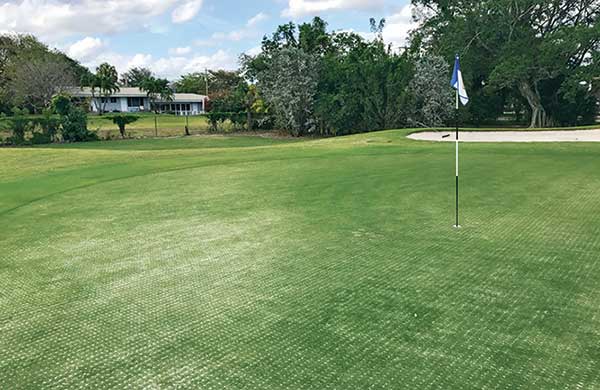Experts’ Insights: Knocking out nematodes

Nematodes often can be detected by irregularly shaped patches of declining turf. (Photo: Syngenta)
Because nematodes are microscopic worms that live in soil and feed on turfgrass roots, it’s often necessary to send a soil sample to a diagnostic lab to confirm that they’ve taken over a given area.
However, there are ways to deduce if there’s a nematode problem, according to William Crow, Ph.D., professor of nematology at the University of Florida.
“Look for irregularly shaped patches of turf that’s declining,” he says. “Sometimes you have chlorosis. There may be areas where you have to irrigate more often, where the grass seems to wilt quicker, and that’s because the roots are damaged, and the grass can’t get the water it needs. You can have increased problems with weeds, because the nematodes don’t feed on them, and that gives the weeds a competitive advantage.”
Crow also suggests taking a look at the grassroots. “If you have a robust, healthy root system, you probably don’t have to worry about nematodes, but if you have a weak or shallow root system, that can indicate a nematode problem,” he says.
Generally, nematodes are most active when grass is growing. While nematodes in northern climates may be dormant in the winter, nematodes in Florida may be active year-round. Additionally, different regions contend with different species of nematodes.
Maintaining good turf health and promoting a healthy root system by reducing shade, aerifying and minimizing traffic patterns can help reduce the threat of nematodes, according to Crow.
Crow recommends sampling nursery greens for nematodes and cleaning equipment well after aerating an affected area. He cautions against overseeding in the Transition Zone, because it’s warm enough for nematodes to survive in the wintertime, and the population can build if new food is put out for them.
For control, Crow says products with fluopyram and abamectin help eradicate nematodes, but it’s important to read the label to determine the application rate and the type of nematodes the product is meant to control.

Lane Tredway (Photo: Syngenta)
Syngenta
Lane Tredway, Ph.D.
Technical services manager
Perhaps the most effective control practice is to prevent nematodes from becoming established in the first place. Once nematodes are established, eradication is not possible, and a long-term management program will be necessary. We can manage nematode populations below established thresholds with cultural practices to minimize turf stress. An ideal growing environment, adequate irrigation and fertilization and increased mowing heights can increase the turf’s tolerance to nematode feeding. Also, ensure soil and planting materials (sod or sprigs) brought onto the property are nematode-free. If populations approach threshold values, consider nematicide applications in the spring and fall to help protect new root growth. These times are when nematode populations increase exponentially and when applications will help provide the greatest benefit.

Todd Lowe (Photo: Bayer)
Bayer
Todd Lowe
Technical services manager
Managing nematode-infected turf requires an integrated approach. Light and frequent irrigation and fertilization are necessary when roots become compromised. Aerification can help improve turf rooting, but avoid excessive dethatching and low mowing when roots are weak. Limit root diseases like Pythium root rot, take-all root rot or summer patch with a preventive fungicide program. A number of nematicides currently are available, including some with the active ingredient fluopyram, to control nematodes and improve turfgrass roots. Superintendents should evaluate each product and select what is best for their property based on cost per days of expected control, application flexibility, species controlled and longevity of control. Unfortunately, there are no current effective products that control lance nematodes, which can be a concern for some golf courses.

Nate Watkin (Photo: Nate Watkin)
Seagate CC
Nate Watkin
Superintendent
We’re in Del Ray Beach, Fla., on an extremely sandy site, and nematodes affect pretty much every property down here in South Florida. We have them (sting, lance and root-knot nematodes) in greens and tees and fairways. We never can eliminate them, but it’s something we hope to control. Visually, we see stressed, corroded and thin turf, especially on the greens, and then in the fairways. It looks like a dry spot, and when we put additional water out, nothing happens, so we pull some samples and send them to a lab. They’re most active in the summertime, when the soil temperatures are warmer. We try to keep fertilizing the sandier sites with organics and try to build the soil, which makes for a stronger plant, and we put out sludge. Chemically, we use a product with active ingredient fluopyram, and we apply that once in the fall and once in the spring. We always observe turf conditions, and it’s wise to get some samples to know for sure what you’re seeing.

Ian Rodriguez (Photo: Quali-Pro)
Quali-Pro
Ian Rodriguez, Ph.D.
Technical services manager
Managing nematodes requires having a good understanding of the species being targeted and managing expectations. Turf type and soil characteristics have a great influence on if or when a nematode species can become problematic, so becoming familiar with the most troublesome types in a region is a good starting point. Knowing when the peak activity for each species occurs allows superintendents to time nematicide applications preventively, rather than waiting for signs of damage. In a prolonged management program, some rotation between active ingredients is a good idea, but be aware that control spectrums vary. Like most other turf problems, cultural practices that promote root health such as core aeration and raising mowing heights can increase tolerance. Since nematode counts can widely fluctuate seasonally — even just a few feet away from a sample point — comparing results based on the health of the root system compared to an untreated area probably is the best way to judge success.











